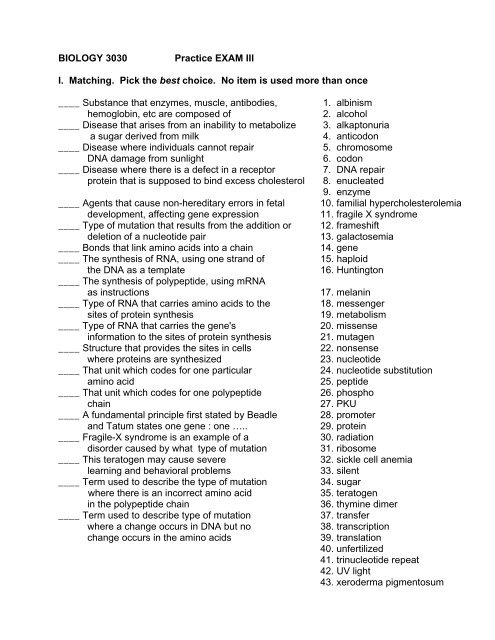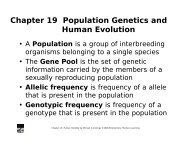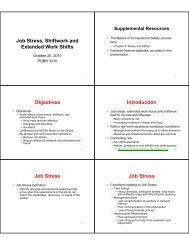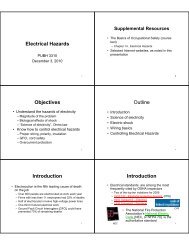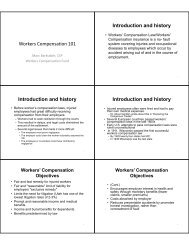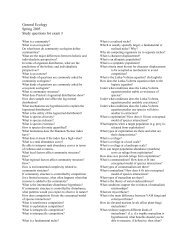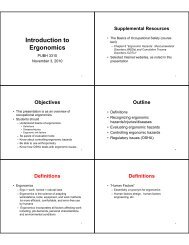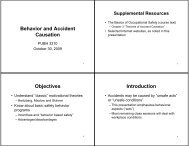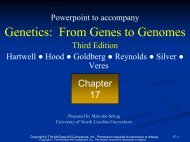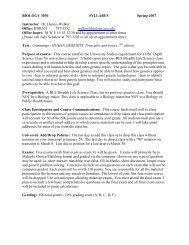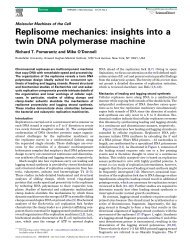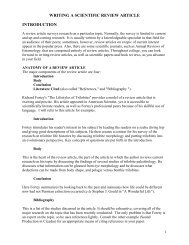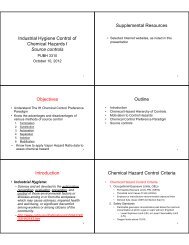BIOLOGY 3030 Practice EXAM III I. Matching. Pick the best choice ...
BIOLOGY 3030 Practice EXAM III I. Matching. Pick the best choice ...
BIOLOGY 3030 Practice EXAM III I. Matching. Pick the best choice ...
You also want an ePaper? Increase the reach of your titles
YUMPU automatically turns print PDFs into web optimized ePapers that Google loves.
<strong>BIOLOGY</strong> <strong>3030</strong><br />
<strong>Practice</strong> <strong>EXAM</strong> <strong>III</strong><br />
I. <strong>Matching</strong>. <strong>Pick</strong> <strong>the</strong> <strong>best</strong> <strong>choice</strong>. No item is used more than once<br />
____ Substance that enzymes, muscle, antibodies,<br />
hemoglobin, etc are composed of<br />
____ Disease that arises from an inability to metabolize<br />
a sugar derived from milk<br />
____ Disease where individuals cannot repair<br />
DNA damage from sunlight<br />
____ Disease where <strong>the</strong>re is a defect in a receptor<br />
protein that is supposed to bind excess cholesterol<br />
____ Agents that cause non-hereditary errors in fetal<br />
development, affecting gene expression<br />
____ Type of mutation that results from <strong>the</strong> addition or<br />
deletion of a nucleotide pair<br />
____ Bonds that link amino acids into a chain<br />
____ The syn<strong>the</strong>sis of RNA, using one strand of<br />
<strong>the</strong> DNA as a template<br />
____ The syn<strong>the</strong>sis of polypeptide, using mRNA<br />
as instructions<br />
____ Type of RNA that carries amino acids to <strong>the</strong><br />
sites of protein syn<strong>the</strong>sis<br />
____ Type of RNA that carries <strong>the</strong> gene's<br />
information to <strong>the</strong> sites of protein syn<strong>the</strong>sis<br />
____ Structure that provides <strong>the</strong> sites in cells<br />
where proteins are syn<strong>the</strong>sized<br />
____ That unit which codes for one particular<br />
amino acid<br />
____ That unit which codes for one polypeptide<br />
chain<br />
____ A fundamental principle first stated by Beadle<br />
and Tatum states one gene : one …..<br />
____ Fragile-X syndrome is an example of a<br />
disorder caused by what type of mutation<br />
____ This teratogen may cause severe<br />
learning and behavioral problems<br />
____ Term used to describe <strong>the</strong> type of mutation<br />
where <strong>the</strong>re is an incorrect amino acid<br />
in <strong>the</strong> polypeptide chain<br />
____ Term used to describe type of mutation<br />
where a change occurs in DNA but no<br />
change occurs in <strong>the</strong> amino acids<br />
1. albinism<br />
2. alcohol<br />
3. alkaptonuria<br />
4. anticodon<br />
5. chromosome<br />
6. codon<br />
7. DNA repair<br />
8. enucleated<br />
9. enzyme<br />
10. familial hypercholesterolemia<br />
11. fragile X syndrome<br />
12. frameshift<br />
13. galactosemia<br />
14. gene<br />
15. haploid<br />
16. Huntington<br />
17. melanin<br />
18. messenger<br />
19. metabolism<br />
20. missense<br />
21. mutagen<br />
22. nonsense<br />
23. nucleotide<br />
24. nucleotide substitution<br />
25. peptide<br />
26. phospho<br />
27. PKU<br />
28. promoter<br />
29. protein<br />
30. radiation<br />
31. ribosome<br />
32. sickle cell anemia<br />
33. silent<br />
34. sugar<br />
35. teratogen<br />
36. thymine dimer<br />
37. transfer<br />
38. transcription<br />
39. translation<br />
40. unfertilized<br />
41. trinucleotide repeat<br />
42. UV light<br />
43. xeroderma pigmentosum
II. True or False<br />
___ 1. The proteins that make up much of an organism’s body come directly<br />
from <strong>the</strong> diet, ra<strong>the</strong>r than being syn<strong>the</strong>sized by <strong>the</strong> cells.<br />
___ 2. PKU is a metabolic disease that, if untreated, causes severe mental retardation.<br />
___ 3. Most chemical substances that have been tested have been found to be<br />
mutagenic.<br />
___ 4. Most substances that are mutagenic are also carcinogenic.<br />
___ 5. Many mutations occur on <strong>the</strong>ir own, spontaneously.<br />
___ 6. Fetal alcohol syndrome babies suffer from genetic damage that can be<br />
passed on to <strong>the</strong>ir offspring when <strong>the</strong>y (<strong>the</strong> FAS babies) attain<br />
reproductive age.<br />
___ 7. Most teratogens cause gene mutations.<br />
___ 8. Transfer RNAs contain triplet anticodons that match up against mRNA codons<br />
at <strong>the</strong> ribosomes.<br />
___ 9. There are 4 different kinds of amino acids, as compared to 20 different<br />
nucleotides in DNA.<br />
___ 10.The degeneracy of <strong>the</strong> genetic code means that each mRNA code word<br />
can stand for any of several amino acids.<br />
___ 11. Usually, T is found in RNA and U in DNA.<br />
___ 12. The complex disease sickle cell anemia results from a change in just<br />
one nucleotide pair along a gene.<br />
___ 13. Humans have an entirely different genetic code dictionary than o<strong>the</strong>r<br />
organisms.<br />
___ 14. Several different genes usually code for <strong>the</strong> same enzyme, so <strong>the</strong><br />
system has a backup if gene mutation occurs.<br />
___ 15. Afro-Americans have a higher frequency of sickle cell anemia because<br />
heterozygotes are favored in regions of <strong>the</strong> world where malaria occurs.<br />
___ 16. Tumor suppressor genes encode proteins that suppress cell division.<br />
___ 17. Retinoblastoma occurs mainly in adults.<br />
___18. Protooncogenes are normal cellular genes that encode proteins that initiate or<br />
maintain cell division.
___ 19. Mutations in <strong>the</strong> BRCA1 and BRCA2 genes account for most cases of breast<br />
cancer.<br />
____20. Breast cancer only occurs in females.<br />
____21. The United States has <strong>the</strong> lowest age-adjusted Cancer death rate in <strong>the</strong> world.<br />
___ 22. Most lung cancer in <strong>the</strong> United States is associated with smoking.<br />
___ 23. Colon cancer is usually preceded by benign tumors known as polyps.<br />
___ 24. For retinoblastoma to develop a cell must lose both copies of <strong>the</strong> RB tumor<br />
suppressor gene.<br />
___25. Some viruses carry oncogenes as part of <strong>the</strong>ir genetic material.<br />
<strong>III</strong>. Multiple <strong>choice</strong>, select <strong>the</strong> single <strong>best</strong> <strong>choice</strong>.<br />
1. A typical value for a gene mutation rate (per gene per generation) is (a) 1 in 100 (10 -2 ),<br />
(b) 1 in 1000 (10 -3 ), (c) 1 in 10,000 (10 -4 ), (d) 1 in a million (10 -6 )<br />
2. A mutagen on DNA in skin cells, that doesn't have <strong>the</strong> energy to mutate DNA in<br />
cells within <strong>the</strong> body, is (a) alcohol, (b) ionizing radiation, (c) UV light, (d) X-rays<br />
3. A major cause of mental retardation is (a) fragile-X syndrome, (b) familial<br />
hypercholesterolemia, (c) albinism, (d) Huntington’s disease<br />
4. Ultraviolet light damages DNA by causing <strong>the</strong> formation of (a) double-strand breaks<br />
in <strong>the</strong> DNA, (b) changes of C to U, (c) ionized OH radicals, (d) thymine dimers in <strong>the</strong> DNA.<br />
5. Studies have shown that DNA in typical skin cells undergoes vast amounts of damage<br />
from sunlight and from background radiation and chemicals, as well as spontaneously.<br />
The usual result of this damage is (a) death of <strong>the</strong> cells, (b) large numbers of mutations<br />
that greatly impair cell function, (c) premature aging, (d) no effect on <strong>the</strong> overall cell<br />
metabolism because humans possess highly effective DNA repair systems.<br />
6. The most common function of a gene is to specify <strong>the</strong> production of a particular<br />
(a) amino acid, (b) chromosome, (c) polypeptide, (d) sugar<br />
7. A gene consists of (a) a section of DNA beginning with a promoter region and<br />
ending with a terminator regions, (b) a section of DNA beginning with a AUG<br />
codon and ending with a stop codon, (c) a section of protein beginning with <strong>the</strong><br />
amino acid methionine and ending with a stop codon, (d) a ribosome reading along<br />
mRNA and bringing in amino acids.<br />
8. Translation consists of <strong>the</strong> following:<br />
(a) mRNA carries amino acids and is produced from DNA,<br />
(b) tRNAs carry amino acids and read rRNA at ribosomes,<br />
(c) rRNAs carry amino acids and read mRNA codons at ribosomes,
(d) tRNAs carry amino acids and read mRNA codons at ribosomes<br />
9. A metabolic disease that all newborns are screened for in all 50 states.<br />
(a) albinism, (b) Huntington’s, (c) PKU, (d) sickle cell anemia<br />
10. On <strong>the</strong> template strand of DNA (<strong>the</strong> strand that serves as <strong>the</strong> basis for<br />
making rRNA), a mutation occurs that changes a GCC code word to TCC.<br />
The result of <strong>the</strong> change on <strong>the</strong> polypeptide is a (a) missense mutation,<br />
(b) nonsense mutation, (c) sense mutation, (d) silent mutation. Use a<br />
genetic code table to work through this question.<br />
11. The most common form of cancer in <strong>the</strong> United States is cancer of <strong>the</strong> (a) breast, (b)<br />
prostate, (c) lung, (d) skin.<br />
12. Metastasis refers to <strong>the</strong> process in which (a) tumors cells die after chemo<strong>the</strong>rapy, (b)<br />
tumor cells move to new sites in <strong>the</strong> body, (c) benign tumors grow larger, (d) cancer cells<br />
encourage new blood vessels to grow next to <strong>the</strong>m.<br />
13. Sproadic retinoblastoma typically (a) involves cancer in both eyes, (b) occurs in one eye<br />
in adults over 55, (c) occurs in one eye in <strong>the</strong> latter years of childhood, (d) occurs in both<br />
eyes of college-aged individuals.<br />
14. The most aggressive form of skin cancer is (a) retinoblastoma, (b) basal cell carcinoma,<br />
(c) squamous cell carcinoma, (d) malignant melanoma.<br />
15. Xeroderma pigmentosum is an inherited form of (a) skin cancer, (b) eye cancer, (c)<br />
breast cancer, (d) colon cancer, (e) prostate cancer.<br />
16. The Philadelphia chromosome was generated by (a) an inversion, (b) a reciprocal<br />
translocation, (c) a deletion, (d) a duplication.<br />
IV. Longer answer questions.<br />
1. Suppose you have a DNA molecule whose sequence within a certain gene<br />
begins with A T G G G G C T A …..<br />
T A C C C C G A T ….. template strand for transcription<br />
(a) Write out <strong>the</strong> mRNA made from this gene<br />
(b) What will be <strong>the</strong> first three amino acids in <strong>the</strong> polypeptide chain (use a genetic<br />
code table)?<br />
(c) What are <strong>the</strong> anticodons that are expected on <strong>the</strong> tRNAs?
2. What are <strong>the</strong> following: an amino acid, an anticodon, a codon, an enzyme, a gene, a<br />
nucleotide, a peptide bond, a phospodiester bond, a promoter, a mRNA, a rRNA, a<br />
tRNA, a ribosome, transcription, translation, mutation?<br />
3. In <strong>the</strong> case of sickle cell anemia, explain what is wrong with <strong>the</strong> DNA and<br />
with <strong>the</strong> protein, and what causes <strong>the</strong> harmful effects on <strong>the</strong> person.<br />
4. Describe what happens to <strong>the</strong> DNA, what happens to <strong>the</strong> polypeptide (protein),<br />
and whe<strong>the</strong>r it is serious or not for silent mutations, missense mutations, and<br />
nonsense mutations.<br />
5. In <strong>the</strong> case of PKU, explain what is wrong with metabolism in cells, what happens to<br />
cause <strong>the</strong> disease, and what treatment is used.


